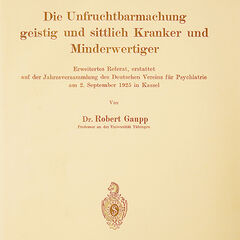Psychiatric Hospital: Forced Sterilizations during National Socialism
Station im Stadtrundgang: History Path to National Socialism
During the Nazi era, patients of Tübingen's university hospitals became the victims of medical crimes. Medical practitioners from Tübingen were directly involved in implementing the "Gesetz zur Verhütung erbkranken Nachwuchses" (Law for the Prevention of Genetically Diseased Offspring). They conducted over a thousand forced sterilizations, especially on mentally ill or allegedly "schwachsinnig" (feeble-minded) human beings.
In 1934, the Nervenklinik (psychiatric hospital) pressed charges against more than a third of its patients for sterilizations to the responsible authorities. In 1936 alone, the clinic's staff prepared 180 reports for sterilization procedures. Between 1934 and 1944, over 1,100 men, women, and children who had been declared "erbkrank" ("hereditarily diseased") were sterilized in the university's Frauenklinik (gynecological hospital) and Chirurgische Klinik (surgical hospital). As a result, at least four women died.
Tübingen inhabitant Anna W. described how she was forced to undergo surgery in the gynecological hospital: "This operation was conducted against my and my husband's explicit wishes. [...] A few days prior to the surgery, I received a summons by the Tübingen Gesundheitsamt (public health office), requesting me to appear at the gynecological hospital; otherwise, I would have to face apprehension by the police."
During the last year of war, physicians from Tübingen University, by order of the Reichskriminalpolizeiamt (Reich Criminal Police Office), forcibly sterilized Sinti for “racial“ reasons.
Image 1
August Mayer (1876-1968), gynecologist and director of the Frauenklinik (gynecological hospital) from 1917 to 1949, giving a university class, undated. Under his direction, at least 655 women underwent forced sterilizations at the gynecological hospital. Photo: University Archives Tübingen
Image 2
Already in his 1925 publication Sterilizing Mentally Ill and Morally Depraved Patients and Inferiors, Robert Gaupp (1870-1953), director of the Nervenklinik (psychiatric clinic), demanded eugenic sterilizations. Gaupp was not a member of the Nationalsozialstische Deutsche Arbeiterpartei (National Socialist German Workers' Party, NSDAP). From the 1920s on, eugenicist positions were very widespread internationally and shared by many political parties in Germany. 1934 then saw the beginning of sterilizations in Germany. Photo: University Library Tübingen
Image 3
Robert Ritter (1901-1951), on the right, interrogates a Sintisa, undated. Until 1935, Ritter was senior physician at the Nervenklinik (psychiatric hospital). From 1936 on, he headed a research center in Berlin that classified about 24,000 people as "gypsies" or "mixed-blood gypsies". From 1943 on, this data was used to select individuals for deportation. Federal Archives Berlin




